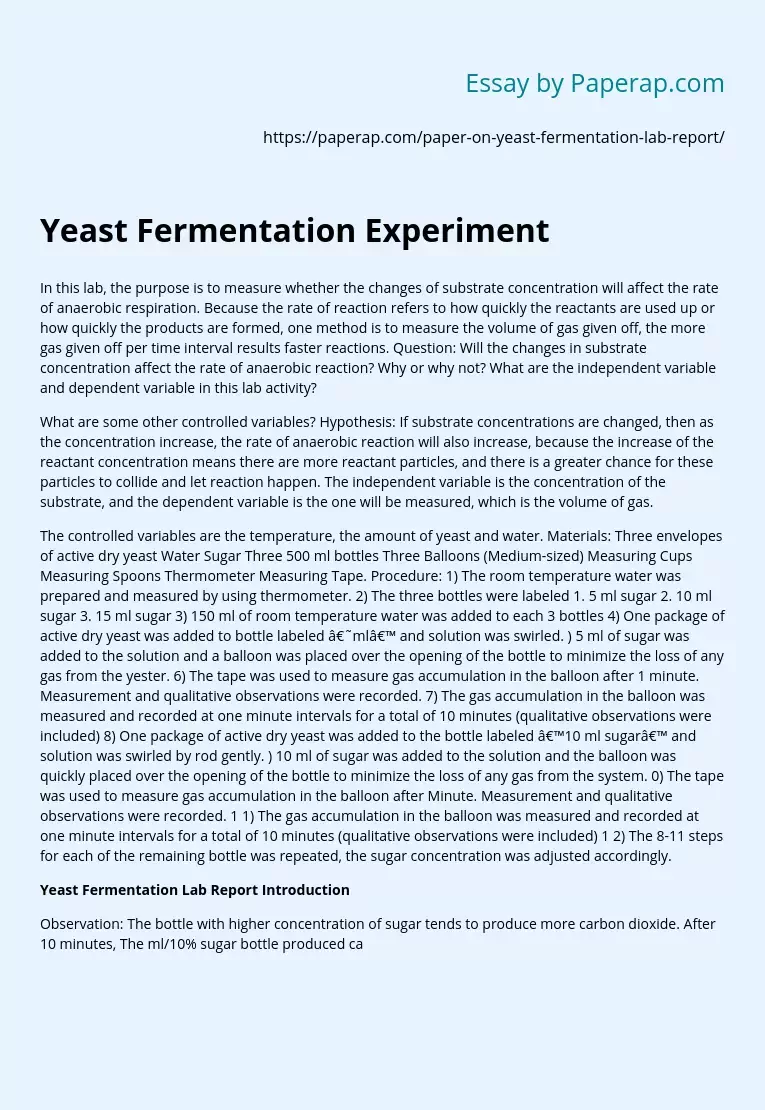Yeast Fermentation Experiment
In this lab, the purpose is to measure whether the changes of substrate concentration will affect the rate of anaerobic respiration. Because the rate of reaction refers to how quickly the reactants are used up or how quickly the products are formed, one method is to measure the volume of gas given off, the more gas given off per time interval results faster reactions. Question: Will the changes in substrate concentration affect the rate of anaerobic reaction? Why or why not? What are the independent variable and dependent variable in this lab activity?
What are some other controlled variables? Hypothesis: If substrate concentrations are changed, then as the concentration increase, the rate of anaerobic reaction will also increase, because the increase of the reactant concentration means there are more reactant particles, and there is a greater chance for these particles to collide and let reaction happen.
The independent variable is the concentration of the substrate, and the dependent variable is the one will be measured, which is the volume of gas.
The controlled variables are the temperature, the amount of yeast and water. Materials: Three envelopes of active dry yeast Water Sugar Three 500 ml bottles Three Balloons (Medium-sized) Measuring Cups Measuring Spoons Thermometer Measuring Tape. Procedure: 1) The room temperature water was prepared and measured by using thermometer. 2) The three bottles were labeled 1. 5 ml sugar 2. 10 ml sugar 3. 15 ml sugar 3) 150 ml of room temperature water was added to each 3 bottles 4) One package of active dry yeast was added to bottle labeled ‘ml’ and solution was swirled.
) 5 ml of sugar was added to the solution and a balloon was placed over the opening of the bottle to minimize the loss of any gas from the yester. 6) The tape was used to measure gas accumulation in the balloon after 1 minute. Measurement and qualitative observations were recorded. 7) The gas accumulation in the balloon was measured and recorded at one minute intervals for a total of 10 minutes (qualitative observations were included) 8) One package of active dry yeast was added to the bottle labeled ’10 ml sugar’ and solution was swirled by rod gently. ) 10 ml of sugar was added to the solution and the balloon was quickly placed over the opening of the bottle to minimize the loss of any gas from the system. 0) The tape was used to measure gas accumulation in the balloon after Minute. Measurement and qualitative observations were recorded. 1 1) The gas accumulation in the balloon was measured and recorded at one minute intervals for a total of 10 minutes (qualitative observations were included) 1 2) The 8-11 steps for each of the remaining bottle was repeated, the sugar concentration was adjusted accordingly.
Yeast Fermentation Lab Report Introduction
Observation: The bottle with higher concentration of sugar tends to produce more carbon dioxide. After 10 minutes, The ml/10% sugar bottle produced carbon dioxide, which occupied the balloon with 4. Inches, while mi/3% sugar bottle only released carbon dioxide that occupied 2. Inches. Results: Concentration (ml/ml) Carbon dioxide produced/ 1 min (Inches) Carbon dioxide produced/mains Carbon dioxide produced/l Onions 3% 0. 0125 1. 1875 2. 25 6. 7% 0. 025 2. 0 3. 3125 0. 0625 2. 24 4. 75 Graphs: Discussion: This lab was designed to prove whether the concentration of the reactants (sugar) would impact the rate of reaction. There are three patterns of the results. ml sugar/ ICC/2. Inches, ml sugar / ICC 13. 1 Inches, ml sugar/ICC/ 4. Inches. According to the statistics, the bottle with highest concentration of bottle produced carbon dioxide that accumulated 4,375 inches of the balloon, compared to ml sugar bottle that only accumulated 2. Inches. The rate of fermentation will increase as the concentration of sugar increase.
In fact, a reaction only occurs when the particles collide with energies greater or equal to the activation energy, so the increasing number of particles means the particles will collide to each other more often, and the kinetic and thermal energies will also increase Therefore, the hypothesis is accepted. There might be some sources of errors, which may occur in the procedures, the first concern is about the controlled variables, temperature does impact the rate of reaction significantly, so it’s necessary to make sure that temperature of the water is constant.
Yeast Fermentation Experiment. (2019, Dec 05). Retrieved from https://paperap.com/paper-on-yeast-fermentation-lab-report/

